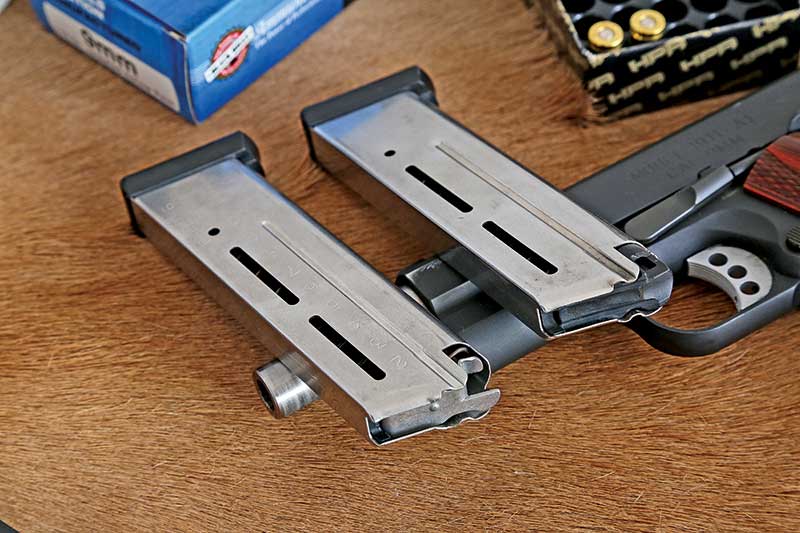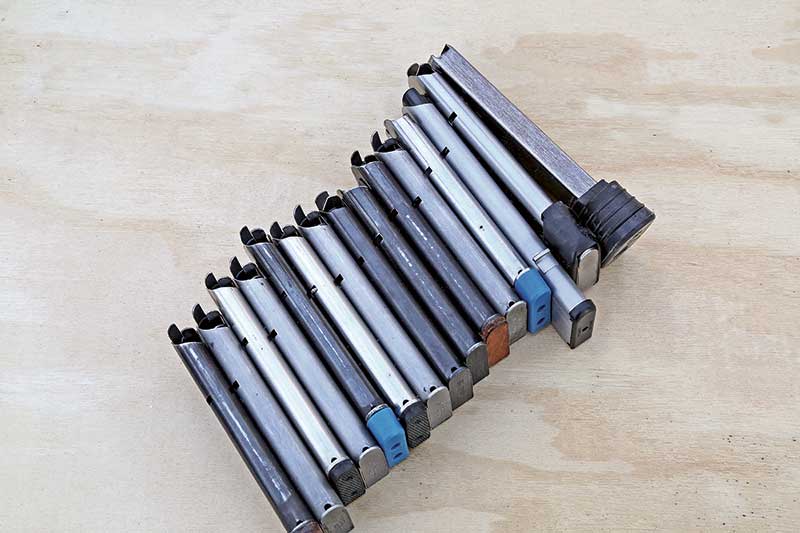Magazine Management
Development of the “modern” 1911 really got going in the late ’70’s. The 1911 pistol virtually ruled competition, though seldom in stock form. We soon found a stock 1911 wasn’t as reliable as legends said it was, even when shooting factory ball ammunition. Modifications such as barrel throating, polishing feed ramps, enlarging ejection ports, tuning extractors and ejectors and so forth improved reliability. But the single most important innovation was better magazines.
Colt magazines had a pretty good reputation but finding even one spare was a challenge, never mind half a dozen. GI magazines could sometimes be found at gun shows, and there were various no-name mags to be found here and there. Even the best weren’t always reliable, and if they were they didn’t stay reliable long. There was wear from heavy use, and even tougher was the type of use. Speed reloading meant magazines being dropped onto the ground and fresh magazines being slammed into the mag well. Sometimes the nature of a stage made it logical to dump a partially loaded magazine and that’s hard on any magazine.
Most magazines back then had their baseplate tacked on with four little dabs of solder or weld. Sometimes one or two “corners” would fail without being noticed. You’d find out when you slammed a fresh magazine into the pistol and base plate, magazine spring, follower and cartridges would spray all over the range.
Often even new magazines wouldn’t drop free. I remember sanding and tapping high spots on magazines so they’d drop free. Or the rear seam on some magazines would fail, letting the magazine lips spread so they wouldn’t feed properly. Or the little tab on followers would bend so either they wouldn’t engage the slide stop to lock the slide back, or worse, jump the slide stop so the magazine had to be pried from the gun.
Fortunately while most of us complained and tried to cope, a few set out to resolve the issues. Bill Wilson and Bill Rogers designed the Wilson magazines. I bought six in 1985, for .45 ACP of course. What a thrill it was to have dependable magazines! Currently McCormick, Mec-Gar and Wilson are my personal favorites though there are other good ones.

Original Colt 1911 magazine (L) had a rear seam which on occasion opened up.
Note square corners in cutout for slide at top rear of magazine body. Several times
I’ve known mags to crack in these corners. Wilson’s, made of seamless tubing, has
rounded cutout and no sharp corners where cracks might start.
New Ideas
Bill Wilson recently redesigned his 1911 single stack 9mm magazines. My shooting buddy Steve Kukowski has a custom Springfield Armory 9mm which we used to test a couple of the new magazines. Steve was already using Wilson mags, so we were able to compare old and new. The main difference is the steel follower. Older magazines used some sort of high-tech synthetic material. Apparently some shooters found due to prolonged use the synthetic would wear enough it would no longer reliably activate the slide stop when empty.
The new magazines are also numbered to show how many rounds are loaded. Bill Wilson has fired over 10,000 rounds testing the new magazines. Our total was more like 500, during which magazines and pistol performed flawlessly. In fairness, Steve says he’s never had a failure with his older Wilson magazines either. I do think the newer design will prove more durable in the long run.
Maintenance Tips
There are a few things you can do to prolong the life of your magazines. Practice your speed reloads over some sort of soft, padded surface. I used to use an old movers’ blanket. Disassemble and clean magazines regularly. Anytime a magazine gets dropped on the ground, during a match for example, it should be cleaned at the first opportunity. Dust or dirt in the magazine tube can retard movement of follower and cartridges. I haven’t found it necessary to change magazine springs very often, but if I do change them I use ISMI springs.
Test magazines at regular intervals to ensure they lock the slide back over an empty magazine and can be easily removed from the pistol whether the slide is forward or back. Keep spare magazines stored in a clean, dust and moisture free case or bag where they can’t rattle around and maybe damage each other.
I like to have one set of carefully tested magazines to use exclusively for matches (or for duty or carry for that matter). A second set is used for routine practice sessions. Individually number each magazine to identify any which develop problems. Don’t scrimp on magazines, either in purchasing or maintaining them. They’re important.





